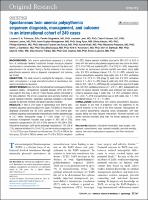| dc.contributor | Vall d'Hebron Barcelona Hospital Campus |
| dc.contributor.author | Tollenaar, Lisanne S. A. |
| dc.contributor.author | Slaghekke, Femke |
| dc.contributor.author | Lewi, Liesbeth |
| dc.contributor.author | Colmant, Claire |
| dc.contributor.author | Lanna, Mariano |
| dc.contributor.author | Weingertner, Anne Sophie |
| dc.contributor.author | Arévalo Martínez, Silvia |
| dc.date.accessioned | 2022-02-25T13:38:02Z |
| dc.date.available | 2022-02-25T13:38:02Z |
| dc.date.issued | 2021-02 |
| dc.identifier.citation | Tollenaar LSA, Slaghekke F, Lewi L, Colmant C, Lanna M, Weingertner AS, et al. Spontaneous twin anemia polycythemia sequence: diagnosis, management, and outcome in an international cohort of 249 cases. Am J Obstet Gynecol. 2021 Feb;224(2):213.e1-213.e11. |
| dc.identifier.issn | 1935-2735 |
| dc.identifier.uri | https://hdl.handle.net/11351/7090 |
| dc.description | Intrauterine transfusion; Laser surgery; Twin anemia polycythemia sequence |
| dc.description.abstract | Background
Twin anemia polycythemia sequence is a chronic form of unbalanced fetofetal transfusion through minuscule placental anastomoses in monochorionic twins, leading to anemia in the donor and polycythemia in the recipient. Owing to the low incidence of twin anemia polycythemia sequence, data on diagnosis, management, and outcome are limited.
Objective
This study aimed to investigate the diagnosis, management, and outcome in a large international cohort of spontaneous twin anemia polycythemia sequence.
Study Design
Data from the international twin anemia polycythemia sequence registry, retrospectively collected between 2014 and 2019, were used for this study. A total of 17 fetal therapy centers contributed to the data collection. The primary outcomes were perinatal mortality and severe neonatal morbidity. Secondary outcomes included a risk factor analysis for perinatal mortality and severe neonatal morbidity.
Results
A total of 249 cases of spontaneous twin anemia polycythemia sequence were included in this study, 219 (88%) of which were diagnosed antenatally and 30 (12%) postnatally. Twin anemia polycythemia sequence was diagnosed antenatally at a median gestational age of 23.7 weeks (interquartile range, 9.7–28.8; range, 15.1–35.3). Antenatal management included laser surgery in 39% (86 of 219), expectant management in 23% (51 of 219), delivery in 16% (34 of 219), intrauterine transfusion (with partial exchange transfusion) in 12% (26 of 219), selective feticide in 8% (18 of 219), and termination of pregnancy in 1% (3 of 219) of cases. Perinatal mortality rate was 15% (72 of 493) for the total group, 22% (54 of 243) for donors, and 7% (18 of 242) for recipients ( P <.001). Severe neonatal morbidity occurred in 33% (141 of 432) of twins with twin anemia polycythemia sequence and was similar for donors (32%; 63 of 196) and recipients (33%; 75 of 228) ( P =.628). Independent risk factors for spontaneous perinatal mortality were donor status (odds ratio, 3.8; 95% confidence interval, 1.9–7.5; P <.001), antenatal twin anemia polycythemia sequence stage (odds ratio, 6.3; 95% confidence interval, 1.4–27.8; P =.016 [stage 2]; odds ratio, 9.6; 95% confidence interval, 2.1–45.5; P =.005 [stage 3]; odds ratio, 20.9; 95% confidence interval, 3.0–146.4; P =.002 [stage 4]), and gestational age at birth (odds ratio, 0.8; 95% confidence interval, 0.7–0.9; P =.001). Independent risk factors for severe neonatal morbidity were antenatal twin anemia polycythemia sequence stage 4 (odds ratio, 7.9; 95% confidence interval, 1.4–43.3; P =.018) and gestational age at birth (odds ratio, 1.7; 95% confidence interval, 1.5–2.1, P <.001).
Conclusion
Spontaneous twin anemia polycythemia sequence can develop at any time in pregnancy from the beginning of the second trimester to the end of the third trimester. Management for twin anemia polycythemia sequence varies considerably, with laser surgery being the most frequent intervention. Perinatal mortality and severe neonatal morbidity were high, the former especially so in the donor twins. |
| dc.language.iso | eng |
| dc.publisher | Elsevier |
| dc.relation.ispartofseries | American Journal of Obstetrics and Gynecology;224(2) |
| dc.rights | Attribution 4.0 International |
| dc.rights.uri | http://creativecommons.org/licenses/by/4.0/ |
| dc.source | Scientia |
| dc.subject | Anèmia - Diagnòstic |
| dc.subject | Làsers en cirurgia |
| dc.subject | Fetus - Malalties |
| dc.subject.mesh | Anemia |
| dc.subject.mesh | Fetofetal Transfusion |
| dc.subject.mesh | /diagnosis |
| dc.subject.mesh | Laser Therapy |
| dc.title | Spontaneous twin anemia polycythemia sequence: diagnosis, management, and outcome in an international cohort of 249 cases |
| dc.type | info:eu-repo/semantics/article |
| dc.identifier.doi | 10.1016/j.ajog.2020.07.041 |
| dc.subject.decs | anemia |
| dc.subject.decs | transfusión fetofetal |
| dc.subject.decs | /diagnóstico |
| dc.subject.decs | tratamiento con láser |
| dc.relation.publishversion | https://doi.org/10.1016/j.ajog.2020.07.041 |
| dc.type.version | info:eu-repo/semantics/publishedVersion |
| dc.audience | Professionals |
| dc.contributor.organismes | Institut Català de la Salut |
| dc.contributor.authoraffiliation | [Tollenaar LSA, Slaghekke F] Division of Fetal Therapy, Department of Obstetrics. [Lewi L] Leiden University Medical Center, Leiden, the Netherlands. Department of Obstetrics and Gynecology, University Hospitals Leuven, Leuven, Belgium. [Colmant C] Department of Obstetrics and Maternal-Fetal Medicine, Hôpital Necker-Enfants Malades, AP-HP, Paris, France. [Lanna M] Fetal Therapy Unit “U. Nicolini,” Vittore Buzzi Children’s Hospital, University of Milan, Milan, Italy. [Weingertner AS] Department of Obstetrics and Gynecology, Strasbourg University Hospital, Strasbourg Cedex, France. [Arévalo S] Unitat de Medicina Maternal-Fetal, Servei d’Obstetrícia, Vall d’Hebron Hospital Universitari, Barcelona, Spain |
| dc.identifier.pmid | 32730900 |
| dc.identifier.wos | 000614552600018 |
| dc.rights.accessrights | info:eu-repo/semantics/openAccess |

